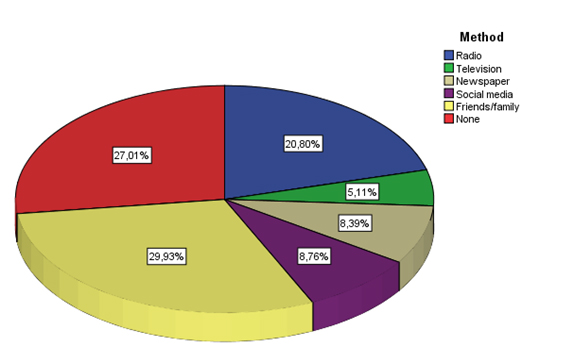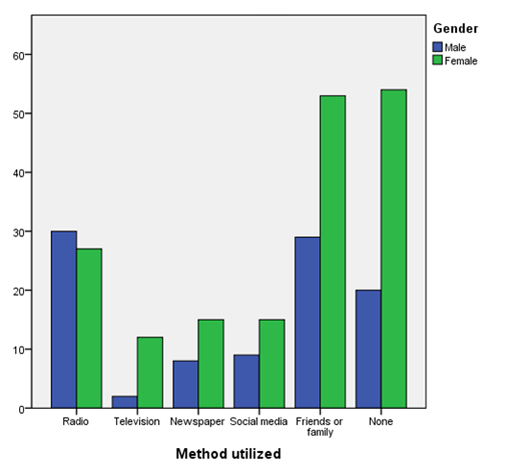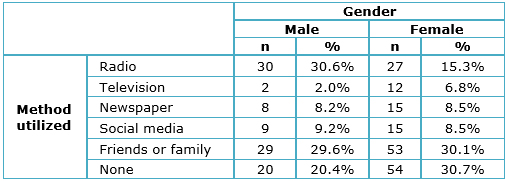Research papers
← vista completaPublished on December 11, 2015 | http://doi.org/10.5867/medwave.2015.11.6334
Use of media for recruiting clinical research volunteers in Ecuador
Uso de los medios de comunicación en la convocatoria a reclutamiento de voluntarios de investigación clínica en Ecuador
Abstract
BACKGROUND Up to this date, there are no reports made about the use of media for recruiting research volunteers in Latin American populations. Given the emergence of clinical research in Ecuador, a study of this kind in the local population will be beneficial for future research, and is probably applicable to other countries in the region.
METHODS Two public calls were made for a cross-sectional study on cognitive function and diabetes. We only included people between 55 and 65 years of age without previous neurocognitive conditions. We invited individuals through interviews on the radio, television broadcasts and local newspapers, along with social media ads. Each individual was asked about the method by which they learned of the project. We calculated the frequency in which each method was reported and a chi-square test was used to assess gender differences in the results.
RESULTS A total of 274 patients were enrolled in the study, 64.2% are women and 35.8% men. We found that 29.93% learned of it from third persons, 20.8% through radio, 8.76% through social media, 8.39% by newspaper, and 5.11% by television, while a remaining 27.01% had not previously heard of the recruitment call. Methods reported varied significantly between men and women (p = 0.03).
CONCLUSIONS Traditional media were the most common method of recruitment, with radio interviews being the most frequently reported. Individually, none of them surpassed the frequency of people learning of the project from other people (snowball effect). Social networks play an important role, exceeding certain traditional media. We have described for the first time in Latin America the use of media as methods to recruit volunteers for research, and the importance of project dissemination by the participants to reach more people.
Introduction
In Ecuador, clinical research and epidemiology are on the first tracks of an evolving and developing process, which should be encouraged [1]. It is necessary to know the characteristics of our population, to improve the methodologic quality of our research. In an inpatient setting, recruitment of research subjects is facilitated by the easy access to patients and electronical medical records. When outpatient research is to be performed, patient recruiting becomes more complicated and requires more attention [2],[3].
There are many previous reports and reviews in English speaking medical literature describing the most effective methods for recruiting and retention of research subjects for many diseases [4],[5],[6]. However, this information has limited utility when we try to apply it to Latin American populations, given the broad cultural and ethical differences presented [7]. Besides, most of these previous reports are focused on recruiting volunteers for controlled clinical trials, in which other factors must be taken into account, compared with observational studies [8],[9],[10]. There have been no reports so far in Latin America about the most effective methods of recruitment for clinical research.
Performing a study that analyzes the use of media methods for recruiting research volunteers in a Latin American population will allow us to determine which types of media are used most frequently, in the outpatient setting. Also, we will be able to compare which are the media most commonly reported between men and women. Finally, we will be able to observe the presence of social media in the diffusion of health campaigns and research projects, given the rise of such media in the last years.
Methods
There is a cross-sectional study currently running in Guayaquil, Ecuador, aiming to determine the prevalence of cognitive decline between diabetic and non-diabetic patients 55 to 65 years of age. During the first stage of this study, two public calls for volunteers were done, on separate dates, at a centric spot of the city (“Malecon 2000”), trying to recruit research subjects for the study. These events were promoted through interviews to the main researchers in local radios, television, and newspapers.
Radio interviews were done at two local stations during the morning schedule, aiming to inform the population who listen to the radio while driving. Two interviews were conducted at local television stations, one in the morning, and another in the afternoon. Also, one interview appeared in a local newspaper and another one in a nationwide circulation newspaper. All of these interviews were performed the week before the recruitment event, giving out all the detailed information about the project and inviting people to participate. Besides, constant diffusion was made through social media, using the official Twitter, Facebook and Instagram accounts of our research group to upload banners containing all the information needed, which were also shared through WhatsApp groups.
This study includes individuals of both genders, ranging from 55 to 65 years, who can read and write. We excluded patients with a clinical history of dementia of any kind, cognitive sequelae of stroke, and those who had not completed at least three years of basic education. During the recruitment event, along with the clinical data collected, we asked each interested participant which kind of media was the mean of getting to know of the event. We also asked if they heard about the event form other people, or if they had not heard of it before and just came to our stand out of curiosity. Every volunteer signed an informed consent to go forward with the main study, authorizing the use of all the data collected during this first stage for analysis.
The data obtained from the surveys was tabulated and analyzed using SPSS Statistics 22 (IBM Corporation, USA). We calculated the frequency with which each kind of media was reported, separately, and also grouping radio, television and newspaper as “conventional media”. To determine if there is a difference between genders and the possibility of using one kind of media more commonly, we used chi-square test with a significant p value of <0.05. We conducted this analysis since we suspected that the varying lifestyles and daily routines of men and women could affect their exposition to one or another media.
Results
After two recruitment events, we managed to include 274 individuals to our study, 98 (35.8%) were males and 176 (64.2%) were females. Regarding the frequency of each kind of media, we found that 57 people (20.8%) listened to the radio interviews, 23 (8.4%) read about it from the newspaper, 14 (5.1%) watched the TV interview, and 24 (8.8%) found it out using social media. On the other side, 82 individuals (29.9%) said that they heard about the project from friends or family members. Finally, 74 people (27%) said that they did not hear about the project before, but were curious about our stand and came to us for information. These results are shown on Figure 1. When adding the radio, TV and newspaper data, we obtained a total of 94 people (34.3%) who found it out using conventional media.

Figure 1 . Frequency of each type of media reported by the surveyed participants (n=274).
When comparing data obtained from men and women as separate groups using chi-square, we obtained a statistically significant result (p=0.03). The distribution of media reported by each gender is shown in Figure 2, while in Table 1 we present the total and percentage of people who reported each method, divided by gender.

Figure 2. Types of media most frequently reported by gender.

Table 1. Reported media used by participants by gender (n=274)
Discussion
We have achieved an acceptable amount of volunteers for research in only two recruitment events, each one running for approximately six hours, which is an indicator of the success of our diffusion campaign for inviting people to our study. After adding the percentages of radio, TV and newspaper usage, conventional media came out as the most frequently reported method, with radio being more common than both newspaper and television. Free access media usage has been previously reported in recruitment for research, but not in Latin American populations, where the cultural factor might offer important differences [11],[12],[13].
Individually, neither of these media was more frequent than the number of cases of people hearing about the project from friends or family members, showing the high level of public diffusion achieved with these types of campaigns. This is known as the “snowball” effect, where one person finds out about the project and tells others, who later tell even more people [14]. The high number of people who were not fit to enter the study because of their age, who told their friends and family members aged 55 to 65 about the project, gives another reasonable explanation.
The second most frequently reported answer was that of people who had not heard of the project before. These individuals noticed our campaign at the stand during the recruitment event, and came to us for more information. Both events were done on weekends, so that the high affluence of people to the recruitment spot helped us to recruit enough volunteers, being “Malecon 2000” a very popular spot in Guayaquil for weekend strolls. Besides, these people told others about the project, again contributing to the “snowball” effect. Previous studies have already demonstrated that positioning the recruitment stand at a high transit spot improves the chances of collecting more research volunteers [9],[15].
In this study, social media have an important percentage that is higher than that of TV and newspapers. This shows the importance of digital media for diffusion of health information in 21th century [16]. Recent studies have observed the use of social media in the application of surveys and clinical trial recruitment, and surely, we have much more to discover regarding their multiple uses in medical research [17],[18],[19].
We have recruited more women than men to our study, with an estimated ratio of 2:1, which suggests that women get more interested in participating in these kind of campaigns, and in receiving information on their health status. Difficulty on recruiting male volunteers has already been reported, although there is not a clear explanation for this [8]. We found a significant difference on the type of method used by men and women, showing that women are more prone to hear about these campaigns from other people, or just be curious about them, while men use conventional media more frequently.
A previous report, which used a sham study to assess the impact of gender and educational level on volunteer recruitment, observed that women were less interested in consenting participation, findings which are the opposite from our study [20]. However, that report used a sham clinical trial, while we are conducting an observational study, and educational level could have had a major impact on their decision, a factor which was not taken into account for our analysis.
These results are probably limited by the relatively small sample of individuals, considering the total population of Guayaquil, and by the fact that we only surveyed individuals ranging from 55 to 65 years of age, thus not allowing us to analyze media usage by age group. Our main study requires individuals in that age range for the further tests and analysis, making it impossible to collect data from other age groups. However, the door is open for future research wanting to evaluate this subject, since interesting data regarding social media usage in younger individuals or conventional media usage in older ones could be found [3],[21]. Another limitation of our study is the design, since we can only offer information on recruiting methods for cross-sectional studies, while cohort or case-control studies could have different recruitment characteristics and new difficulties may arise [8].
Conclusions
We have reported, for the first time in Latin America, the use of media as recruitment methods for research volunteers. Press media continue to have a dominating role in the diffusion of health campaigns, and social media are starting to be more frequently used, even in older individuals. We were able to observe the importance of person to person communication for the diffusion of health campaign information, and the growing interest people have for knowing their general health condition and participating in medical research projects, even if they had not heard of the campaign before. This information can be useful for those who wish to start research projects in Latin American populations, since we have helped determine the advantages of the use of media for spreading the word about recruiting events, and achieving an acceptable sample of research volunteers.
Notes
From the editor
The authors originally submitted this article in Spanish and subsequently translated it into English. The Journal has not copyedited this version.
Ethical aspects
The Journal is aware that the Scientific Ethics Committee of Hospital-Clinic Kennedy learned about this study and possible publication in a journal of biomedical diffusion.
Conflicts of interest
The authors completed the conflict of interests declaration form from the ICMJE, and declared not having any conflict of interests with the matter dealt herein. Forms can be requested to the responsible author or the editorial direction of the Journal.
Financing
This study emerges from a research project funded by the Catholic University of Santiago de Guayaquil.
Acknowledgement
The authors would like to thank María Beatriz Jurado, PhD, Daniel Moreno, MD, Ximena Gamboa, Ibeth Regato, and Carlos Cevallos, members of the Research and Neuroprevention Group of Universidad Católica de Santiago de Guayaquil, for their valuable collaboration in the collection of data for this research.

